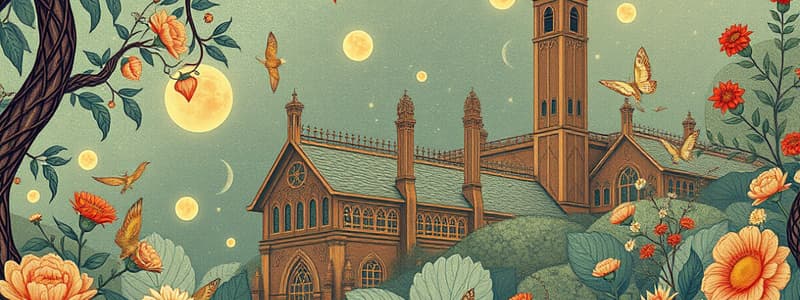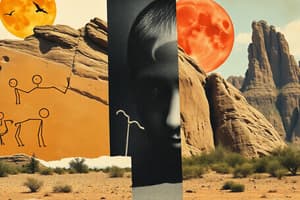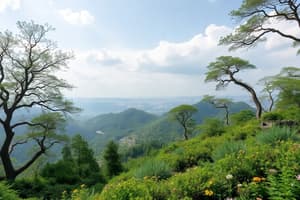Podcast
Questions and Answers
What art movement arose during the 1960s and 1970s that directly altered the existing landscape?
What art movement arose during the 1960s and 1970s that directly altered the existing landscape?
Earthworks
Who wrote the influential environmental book 'Silent Spring'?
Who wrote the influential environmental book 'Silent Spring'?
Rachel Carson
Which of the following are considered key themes in recent environmental art?
Which of the following are considered key themes in recent environmental art?
- Land use and land rights
- Pollution and extraction
- Ecological systems of knowledge
- All of the above (correct)
The Earthworks art movement was focused on creating art that could be moved and displayed in galleries.
The Earthworks art movement was focused on creating art that could be moved and displayed in galleries.
What is 'site-specificity' in relation to Earthworks?
What is 'site-specificity' in relation to Earthworks?
Marcel Duchamp is known for his '__________,' which were ordinary objects displayed as art.
Marcel Duchamp is known for his '__________,' which were ordinary objects displayed as art.
What does contemporary eco art aim to address?
What does contemporary eco art aim to address?
What is art history?
What is art history?
Art historians consider only fine art in their analysis.
Art historians consider only fine art in their analysis.
Which two modes of analysis do art historians generally use?
Which two modes of analysis do art historians generally use?
What do formal analysis and contextual analysis focus on?
What do formal analysis and contextual analysis focus on?
Who was Giorgio Vasari?
Who was Giorgio Vasari?
The oldest works of art considered in this guide are cave paintings found in ________ Cave.
The oldest works of art considered in this guide are cave paintings found in ________ Cave.
When were the paintings in Chauvet Cave discovered?
When were the paintings in Chauvet Cave discovered?
What philosophical movements have influenced modern art history?
What philosophical movements have influenced modern art history?
Art historians may also examine the ________ that existed between the artist and patron.
Art historians may also examine the ________ that existed between the artist and patron.
Who is considered perhaps the most famous artist of Reformation Germany?
Who is considered perhaps the most famous artist of Reformation Germany?
What did Albrecht Dürer aim to achieve in his style?
What did Albrecht Dürer aim to achieve in his style?
The Baroque period moved away from the classic simplicity and calm of Renaissance works.
The Baroque period moved away from the classic simplicity and calm of Renaissance works.
Caravaggio is known for his dramatic use of ______ and ______.
Caravaggio is known for his dramatic use of ______ and ______.
What is the name of the painting by Caravaggio that portrays the Virgin Mary and apostles in a realistic manner?
What is the name of the painting by Caravaggio that portrays the Virgin Mary and apostles in a realistic manner?
Which artist is known for the masterpiece 'Ecstasy of Saint Teresa'?
Which artist is known for the masterpiece 'Ecstasy of Saint Teresa'?
What did the Salon established under Louis XIV influence?
What did the Salon established under Louis XIV influence?
Which artist is recognized for building figures from patches of color?
Which artist is recognized for building figures from patches of color?
The use of ______ by Baroque painters created dramatic imagery.
The use of ______ by Baroque painters created dramatic imagery.
What pigments were used in the paintings and engravings in Chauvet Cave?
What pigments were used in the paintings and engravings in Chauvet Cave?
Which of the following animals are depicted in the paintings of Chauvet Cave? (Select all that apply)
Which of the following animals are depicted in the paintings of Chauvet Cave? (Select all that apply)
The paintings from the Middle Stone Age included human figures.
The paintings from the Middle Stone Age included human figures.
What is the primary purpose of ziggurats in ancient Sumerian culture?
What is the primary purpose of ziggurats in ancient Sumerian culture?
The Great Ziggurat of Ur is located in __________.
The Great Ziggurat of Ur is located in __________.
Who codified the Babylonian law, known as the Code of Hammurabi?
Who codified the Babylonian law, known as the Code of Hammurabi?
What is a notable characteristic of ancient Egyptian art?
What is a notable characteristic of ancient Egyptian art?
Tutankhamun’s tomb was discovered intact in 1922.
Tutankhamun’s tomb was discovered intact in 1922.
The famous burial mask of Tutankhamun is made primarily of __________.
The famous burial mask of Tutankhamun is made primarily of __________.
Which ancient civilization is known for constructing the palace at Persepolis?
Which ancient civilization is known for constructing the palace at Persepolis?
What type of figures did the Cycladic culture produce?
What type of figures did the Cycladic culture produce?
Match the following ancient civilizations with their notable artistic contributions:
Match the following ancient civilizations with their notable artistic contributions:
Who is credited with putting Brunelleschi’s theory into practice?
Who is credited with putting Brunelleschi’s theory into practice?
What is Donatello considered the founder of?
What is Donatello considered the founder of?
What is the name of Botticelli's best-known painting?
What is the name of Botticelli's best-known painting?
Leonardo da Vinci is known as an inventor, architect, and musician.
Leonardo da Vinci is known as an inventor, architect, and musician.
What technique did Leonardo da Vinci innovate in painting?
What technique did Leonardo da Vinci innovate in painting?
What famous statue did Michelangelo create from flawed marble?
What famous statue did Michelangelo create from flawed marble?
What major form did Minoan paintings take?
What major form did Minoan paintings take?
How long did it take Michelangelo to paint the ceiling of the Sistine Chapel?
How long did it take Michelangelo to paint the ceiling of the Sistine Chapel?
What is contrapposto?
What is contrapposto?
What was one of the criticisms Protestants had against the Catholic Church during the Reformation?
What was one of the criticisms Protestants had against the Catholic Church during the Reformation?
The collapse of the Minoan civilization occurred before the rise of the Mycenaean culture.
The collapse of the Minoan civilization occurred before the rise of the Mycenaean culture.
Which painter is credited with innovations in landscape subject matter?
Which painter is credited with innovations in landscape subject matter?
What was a notable architectural achievement restored in 447 BCE?
What was a notable architectural achievement restored in 447 BCE?
Who is considered one of the greatest Renaissance portraitists?
Who is considered one of the greatest Renaissance portraitists?
Which of the following artists is known for their portrayal of dramatic angles and chiaroscuro?
Which of the following artists is known for their portrayal of dramatic angles and chiaroscuro?
Which of the following were characteristics of Roman art?
Which of the following were characteristics of Roman art?
What term is used to refer to artworks produced from the late sixteenth century through the mid-eighteenth century?
What term is used to refer to artworks produced from the late sixteenth century through the mid-eighteenth century?
What style was used in early medieval church architecture?
What style was used in early medieval church architecture?
What artwork is considered Matthias Grünewald’s greatest masterpiece?
What artwork is considered Matthias Grünewald’s greatest masterpiece?
Which feature is typical of Gothic architecture?
Which feature is typical of Gothic architecture?
Who was a prominent artist during the Renaissance known for his frescoes?
Who was a prominent artist during the Renaissance known for his frescoes?
What was a major advancement during the Renaissance related to artists?
What was a major advancement during the Renaissance related to artists?
What key innovation allowed for larger windows in Gothic cathedrals?
What key innovation allowed for larger windows in Gothic cathedrals?
Flashcards are hidden until you start studying
Study Notes
Introduction
- Visual art has interpreted natural environments for millennia, evident in prehistoric cave paintings and Roman murals.
- The genre of landscape painting emerged in the 17th century, depicting nature and its beauty.
Modern Art Movements
- In the 20th century, artists aimed to merge art with everyday life, exemplified by Marcel Duchamp's "readymades."
- Constructivist artists in post-revolution Russia sought to apply art to functional items like clothing and tools.
- By the 1960s, performance art emerged, incorporating ordinary activities into artistic expression.
Environmental Art Development
- The 1960s and 1970s saw a rise in environmental awareness, significantly influencing the art world.
- Publications like Rachel Carson's Silent Spring and disasters like the 1969 Santa Barbara oil spill contributed to this heightened awareness.
- Earthworks artists, such as Robert Smithson and Michael Heizer, altered landscapes to create site-specific artworks, marking a departure from traditional representations of nature.
Site-Specific Art
- Earthworks emphasize the importance of the location, as they cannot be removed or displayed elsewhere like traditional art forms.
- Documentation of these works is often shared, merging human experiences with ecological concerns.
Contemporary Eco Art
- Contemporary eco art seeks to address climate and ecological issues, expanding the conversation to include social and racial equity.
- The movement highlights the impact of settlement histories and technologies on environmental conditions.
Key Themes in Environmental Art
- Land Use and Land Rights: Examination of how land is utilized and the rights associated with it.
- Pollution and Extraction: Addressing the consequences of environmental degradation.
- Ecological Systems of Knowledge: Understanding ecosystems and their complexities.
- Human Experience of Environment: Exploring how humans relate to their environment through art.
Conclusion
- Contemporary eco art builds on historical art movements while aiming for positive change regarding climate and ecology.
- The resource guide serves as a framework for understanding the evolving relationship between visual art and the environment.
Notes for Students
- Boldfaced and underlined terms in the guide have glossary definitions.
- Dates in art history can vary and are often contested; consult different sources for accurate information.### Overview of Art History
- Art history integrates analysis of aesthetics, theological knowledge, and social factors, influencing the understanding of art.
- Social status, education, race, gender, and religious background shape the interpretation of artworks.
Methods and Approaches in Art History
- Art historians analyze artworks through formal and contextual analysis:
- Formal Analysis: Examines visual qualities and intrinsic aspects of the artwork.
- Contextual Analysis: Investigates the cultural, social, and economic context of the artwork’s creation and consumption.
Historical Context
- Art as a discipline emerged in the mid-eighteenth century, influenced by Enlightenment thought.
- Giovanni Vasari’s works offered early insight into artists’ biographies and the evolution of art.
- Modern art history has shifted to include diverse perspectives, expanding beyond traditional focuses on 'great' artists.
Evolution of Art Historical Inquiry
- The interplay between artistic form and historical context defines contemporary art historical methods.
- Comparative studies are utilized, such as contrasting Gothic and Renaissance art to highlight changes in style.
Significant Art Historical Periods
- Old Stone Age: Features cave paintings like those in Chauvet Cave, dating back to approximately 30,000 BCE, depicting animals using natural pigments.
- Middle Stone Age: Art in Lascaux and Altamira reflects a transition to rock shelter paintings showing human figures, indicating changing cultural practices.
New Stone Age Developments
- The Neolithic Period introduced monumental structures, such as Stonehenge, formed from massive stones, underscoring organized societal frameworks.
Influence of Environment on Art Preservation
- Environmental factors play a critical role in the preservation of artworks; arid climates tend to better preserve materials compared to humid ones.
Exploration of Non-Western Civilizations
- Traditional art history has often focused on Western civilizations, neglecting rich artistic traditions outside this scope, particularly in Central and South America.
Conclusion on Art Historical Significance
- Art history is an evolving field that emphasizes the importance of understanding artworks within their specific cultural and historical contexts.### Megalithic Art and Culture
- Megaliths, meaning “great stones,” denote large stone structures created by ancient cultures.
- Stonehenge, located on Salisbury Plain, England, was constructed from 2100 BCE in multiple phases, consisting of sarsen stones and bluestones.
- Post and lintel architecture characterizes Stonehenge, with large sarsen stones weighing up to fifty tons.
- Artwork preservation is more likely in civilizations that protect their art in inaccessible locations.
Ancient Mesopotamian Art
- Mesopotamia, situated between the Tigris and Euphrates Rivers, developed alongside Egyptian culture but faced vulnerability to invasion due to lack of natural barriers.
- Fewer Mesopotamian artworks survive due to the use of perishable materials.
- Sumerians (from 4000 BCE) created significant sculptures and built temples; ziggurats emerged as massive stepped pyramids central to city life.
- Hammurabi’s Code established the oldest complete legal code, depicted on a stele with relief sculpture of Hammurabi receiving divine inspiration.
- Assyrian artworks, particularly relief carvings, reflected their military successes, while Neo-Babylonian period is known for achievements like the Ishtar Gate and the Hanging Gardens.
Ancient Egyptian Art
- Egyptian civilization flourished from 3000 BCE until conquered by Alexander the Great in 332 BCE.
- Iconic artworks include the Sphinx, pyramids of Giza, and the bust of Queen Nefertiti.
- Hierarchical scale determines relative sizes of figures, emphasizing social status, illustrated in the Palette of King Narmer.
- Egyptian art utilizes “fractional representation,” showing different body parts for clarity.
- Mummification practices allowed for well-preserved artifacts, notably Tutankhamun's burial mask made of gold and embellished with semi-precious stones.
Nubian Art
- Nubia, south of Egypt, was a significant civilization that at one point ruled parts of Egypt.
- Recognition of Nubian art is growing, expanding the narrative of ancient African civilizations.
Aegean Art: Cycladic, Minoan, and Mycenaean
- Cycladic culture (3200-2000 BCE) produced simplified, geometric nude female sculptures, rich pottery, and highly decorative items.
- Minoan civilization, centered in Knossos, focused on naturalistic frescoes and suffered collapse around the time the Mycenaean culture peaked.
- Mycenaean art featured elaborate tombs, preserved objects, including exceptional gold artifacts, borrowing stylistic elements from Cycladic and Minoan works.
Ancient Greek Art
- Archaic Period (660-475 BCE) was characterized by stone sculptures inspired by Egyptian art, transitioning to more fluid forms during the Classical Period.
- Contrapposto became a hallmark of Greek sculpture, allowing for more naturalistic representations.
- Major architectural achievement includes the Parthenon, restored in 447 BCE, showcasing Doric columns and classical architectural principles.
Etruscan and Roman Art
- Etruscan art served as a bridge between Greek ideals and Roman pragmatism, known mostly through tomb decorations.
- Roman art, initially influenced by Etruscan and Greek styles, introduced innovations such as concrete, facilitating large structures and domes.
- The Romans excelled in architecture, using arches to construct bridges and aqueducts.
Studying That Suits You
Use AI to generate personalized quizzes and flashcards to suit your learning preferences.




